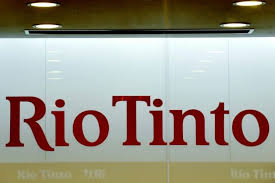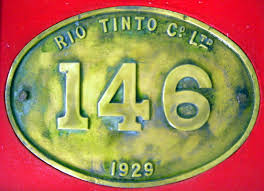The Rio Tinto (Painted River in Spanish) has been mined for copper, silver, and gold since time began. Mining operations have been overseen by the Greeks, Romans, Phoenicians, Iberians, and the Moors. Mining was abandoned for a period and rediscovered by the Spaniards in 1556. The Spanish government took over the mines in 1724. 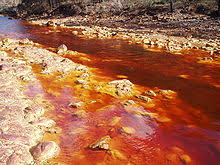
Spain decided to sell the mines in 1872 and held an auction, which was won by Hugh Matheson’s British firm Matheson and Company. Spain relinquished any claim to the mine and the name Rio Tinto was put on the final paperwork in March 1873.
The Rothchild family came into possession of the mine in the late 1880s. They began expanding mining operations substantially. The company began diversifying, acquiring and creating other mining sites in the mid-1920s, including a copper mine in Rhodesia (now Zambia).
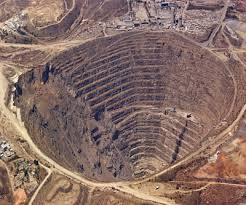 Other mergers and acquisitions include U.S. Borax company in 1968, Kennecott Utah Copper, iron and uranium mine North Limited of Australia, and the Cordero Mining Company.
Other mergers and acquisitions include U.S. Borax company in 1968, Kennecott Utah Copper, iron and uranium mine North Limited of Australia, and the Cordero Mining Company.
The company is split into four divisions;
- Aluminum
- Copper & Diamonds, including gold and silver
- Energy & Minerals, including Borax, salt, and uranium
- Iron ore
In 2011, the U.S. Securities and Exchange Commission began an investigation and placed a $3 billion impairment charge against Rio Tinto regarding a coal deal they made in Mozambique. Rio acquired Riverdale Mining Ltd. The CEO was later forced to step down. 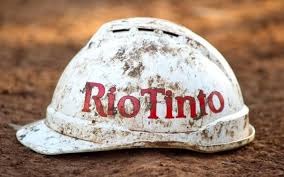
In early November 2016, Former mining minister of Guinea, Mahmoud Thiam, claimed that the head of Rio Tinto’s operation in Guinea offered him a bribe in 2010 in order to win back control of the Simandou mine and that his offer was supported by senior members of the company. The company is currently facing at least 4 class-action suits in the US demanding damages over the corruption allegations in Guinea.
 The company has had record profits in 2018/2019 and is prepared to share more than $4 billion with shareholders. Rio Tinto is a duel-listed company that is traded on both the London Stock Exchange and the Australian Securities Exchange. Additionally, American Depositary Shares of Rio Tinto’s British branch are traded on the New York Stock Exchange, giving its listings on a total of 3 major stock exchanges.
The company has had record profits in 2018/2019 and is prepared to share more than $4 billion with shareholders. Rio Tinto is a duel-listed company that is traded on both the London Stock Exchange and the Australian Securities Exchange. Additionally, American Depositary Shares of Rio Tinto’s British branch are traded on the New York Stock Exchange, giving its listings on a total of 3 major stock exchanges.
Rio Tinto is the world’s largest mining and metal company, with operations on six continents, with its main focus being Australia and Canada.
Rio Tinto
The Rio Tinto (Painted River in Spanish) has been mined for copper, silver, and gold since time began. Mining operations have been overseen by the Greeks, Romans, Phoenicians, Iberians, and the Moors. Mining was abandoned for a period and rediscovered by the Spaniards in 1556. The Spanish government took over the mines in 1724. 
Spain decided to sell the mines in 1872 and held an auction, which was won by Hugh Matheson’s British firm Matheson and Company. Spain relinquished any claim to the mine and the name Rio Tinto was put on the final paperwork in March 1873.
History
The Rothchild family came into possession of the mine in the late 1880s. They began expanding mining operations substantially. The company began diversifying, acquiring and creating other mining sites in the mid-1920s, including a copper mine in Rhodesia (now Zambia).
 Other mergers and acquisitions include U.S. Borax company in 1968, Kennecott Utah Copper, iron and uranium mine North Limited of Australia, and the Cordero Mining Company.
Other mergers and acquisitions include U.S. Borax company in 1968, Kennecott Utah Copper, iron and uranium mine North Limited of Australia, and the Cordero Mining Company.
The company is split into four divisions;
- Aluminum
- Copper & Diamonds, including gold and silver
- Energy & Minerals, including Borax, salt, and uranium
- Iron ore
In 2011, the U.S. Securities and Exchange Commission began an investigation and placed a $3 billion impairment charge against Rio Tinto regarding a coal deal they made in Mozambique. Rio acquired Riverdale Mining Ltd. The CEO was later forced to step down. 
In early November 2016, Former mining minister of Guinea, Mahmoud Thiam, claimed that the head of Rio Tinto’s operation in Guinea offered him a bribe in 2010 in order to win back control of the Simandou mine and that his offer was supported by senior members of the company. The company is currently facing at least 4 class-action suits in the US demanding damages over the corruption allegations in Guinea.
 The company has had record profits in 2018/2019 and is prepared to share more than $4 billion with shareholders. Rio Tinto is a duel-listed company that is traded on both the London Stock Exchange and the Australian Securities Exchange. Additionally, American Depositary Shares of Rio Tinto’s British branch are traded on the New York Stock Exchange, giving its listings on a total of 3 major stock exchanges.
The company has had record profits in 2018/2019 and is prepared to share more than $4 billion with shareholders. Rio Tinto is a duel-listed company that is traded on both the London Stock Exchange and the Australian Securities Exchange. Additionally, American Depositary Shares of Rio Tinto’s British branch are traded on the New York Stock Exchange, giving its listings on a total of 3 major stock exchanges.
Rio Tinto is the world’s largest mining and metal company, with operations on six continents, with its main focus being Australia and Canada.
